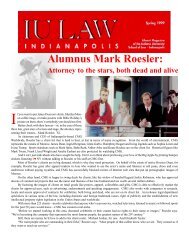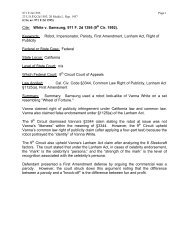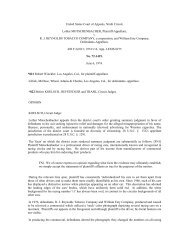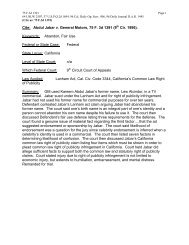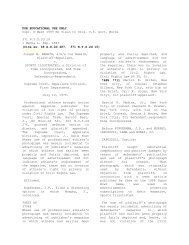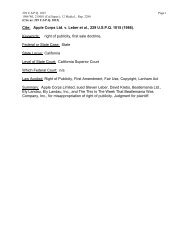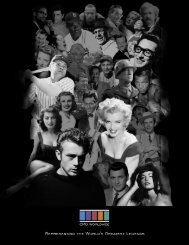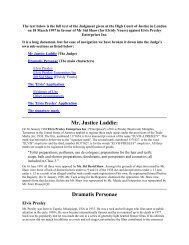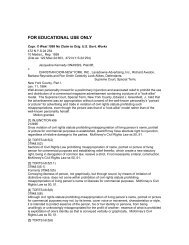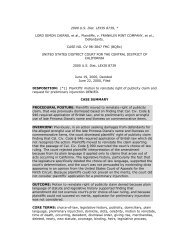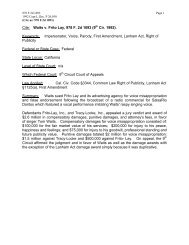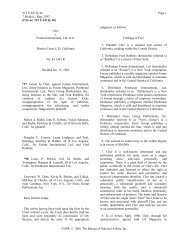Hustler v. Falwell.pdf - Mark Roesler
Hustler v. Falwell.pdf - Mark Roesler
Hustler v. Falwell.pdf - Mark Roesler
You also want an ePaper? Increase the reach of your titles
YUMPU automatically turns print PDFs into web optimized ePapers that Google loves.
[***6] that the ad parody could not "reasonably be understood as describing<br />
actual facts about [respondent] or actual events in which [he] participated."<br />
App. to Pet. for Cert. C1. The jury ruled for respondent on the intentional<br />
infliction of emotional distress claim, however and stated that he should be<br />
awarded $ 100,000 in compensatory damages, as well as $ 50,000 each in<br />
punitive<br />
damages from petitioners. n2 Petitioners' motion for judgment notwithstanding<br />
the verdict was denied.<br />
- - - - - - - - - - - - - - - - - -Footnotes- - - - - - - - - - - - - - - - - -<br />
n1 While the case was pending, the ad parody was published in <strong>Hustler</strong><br />
magazine a second time.<br />
n2 The jury found no liability on the part of Flynt Distributing Co., Inc. It<br />
is consequently not a party to this appeal.<br />
- - - - - - - - - - - - - - - - -End Footnotes- - - - - - - - - - - - - - - - -<br />
On appeal, the United States Court of Appeals for the Fourth Circuit affirmed<br />
the judgment against petitioners. <strong>Falwell</strong> v. Flynt, 797 F. 2d 1270 (CA4 1986).<br />
The court rejected petitioners' argument that the "actual malice" standard of<br />
New York Times Co. v. Sullivan, 376 U. S. 254 (1964), must be met before<br />
respondent can recover for emotional distress. The court agreed that because<br />
respondent is concededly a public figure, petitioners are "entitled to the same<br />
level of first amendment protection [***7] in the claim for intentional<br />
infliction of emotional distress that they received in [respondent's] claim for<br />
libel." 797 F. 2d, at 1274. But this does not mean that a literal application of<br />
the actual malice rule is appropriate in the context of an emotional distress<br />
claim. In the court's view, the New York Times decision emphasized the<br />
constitutional importance not of the falsity of the statement or the defendant's<br />
disregard for the truth, but of the heightened level of culpability embodied<br />
[**879] in the requirement of "knowing . . . or reckless" conduct. Here, the<br />
New York [*50] Times standard is satisfied by the state-law requirement, and<br />
the jury's finding, that the defendants have acted intentionally or recklessly.<br />
n3 The Court of Appeals then went on to reject the contention that because the<br />
PAGE 5<br />
485 U.S. 46, *50; 108 S. Ct. 876, **879;<br />
1988 U.S. LEXIS 941, ***7; 99 L. Ed. 2d 41<br />
jury found that the ad parody did not describe actual facts about respondent,<br />
the ad was an opinion that is protected by the First Amendment. As the court<br />
put<br />
it, this was "irrelevant," as the issue is "whether [the ad's] publication was<br />
sufficiently outrageous to constitute intentional infliction of emotional<br />
distress." Id., at 1276. n4 Petitioners then filed a petition for rehearing en<br />
banc, but [***8] this was denied by a divided court. Given the importance of<br />
the constitutional issues involved, we granted certiorari. 480 U.S. 945 (1987).<br />
- - - - - - - - - - - - - - - - - -Footnotes- - - - - - - - - - - - - - - - - -<br />
n3 Under Virginia law, in an action for intentional infliction of emotional<br />
distress a plaintiff must show that the defendant's conduct (1) is intentional<br />
or reckless; (2) offends generally accepted standards of decency or morality;<br />
(3) is causally connected with the plaintiff's emotional distress; and (4)



